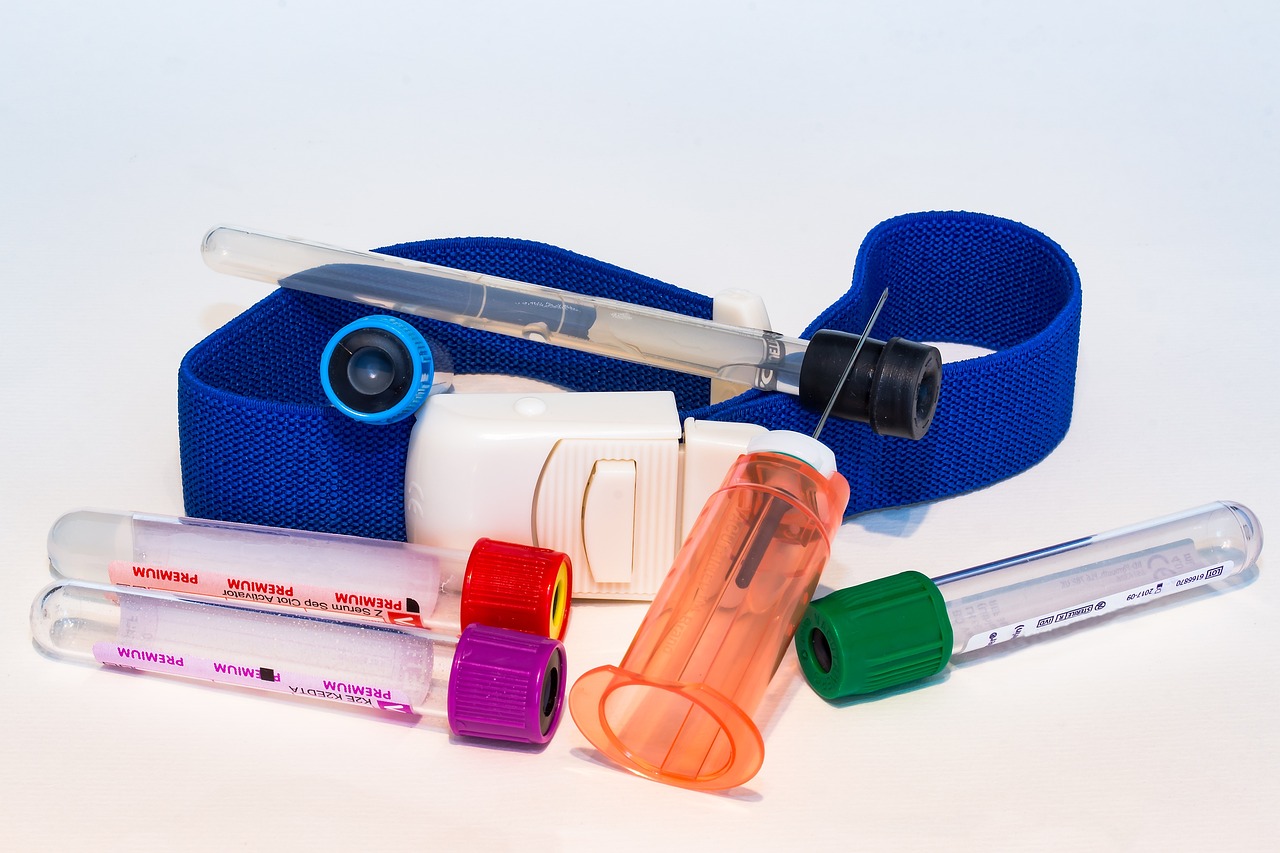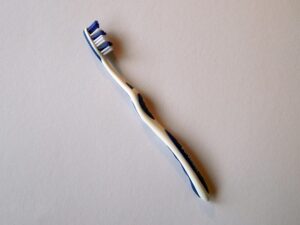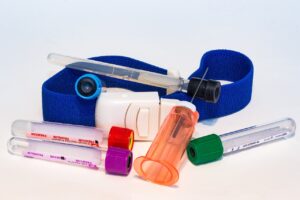
Purpose of Anticoagulants in Lab Testing
Lab testing relies heavily upon blood samples drawn in evacuated collection tubes, sometimes known as “Vacutainers”. They get their name from the fact that they are pre-filled with various amounts of vacuum, enabling the proper volume of blood to be pulled into the tube.
Some tests require a serum sample from clotted blood, acquired by using tubes without anticoagulant like the gold top and red top.
On the other hand, some tests need either whole blood or plasma for analysis. This requires preventing the blood from clotting after it is drawn, by using collection tubes which are pre-filled with anticoagulants. Once the blood is drawn, the tube is inverted back and forth several times in order to get a proper mix. Failure of the phlebotomist to invert the tube can cause a clot and result in the sample being rejected by the lab.
There are several types available, but the most commonly used anticoagulants in the lab are EDTA, Heparin and Sodium Citrate. Let us dive deeper into each one of these so we can highlight their differences as well as determine what makes them essential in laboratory testing.
EDTA Tube (Purple Top)
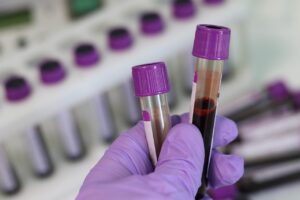
Ethylenediaminetetraacetic Acid, also known as “EDTA”, is an anticoagulant which prevents clotting via the binding of calcium. The EDTA tube color is that of a lavender or purple top. The 4 ml purple top is the most commonly used EDTA tube across the board, although the 6 ml pink top is the tube of choice for any blood bank testing.
The lavender EDTA tube is preferred in hematology due to its ability to preserve cellular morphology, a vital attribute especially when reading smears under the microscope. The most common tests which use the purple top are the Complete Blood Count (CBC), Manual Differential, Malaria Smear, Erythrocyte Sedimentation Rate (ESR) as well as the Sickle Cell screen.
Although its primary purpose is for hematology testing, the lavender top EDTA tube can also be used in other areas of the lab. For chemistry it is used for the Hemoglobin A1C. In Serology, it is frequently used for tests like the Rapid Mono and Rapid HIV. In blood banking, the larger 6ml pink top tube is used for Type and Screens, Crossmatching, cord blood testing and Direct Coombs (DAT) testing.
K2 EDTA Tube vs K3 EDTA tube: K2 (Dipotassium) EDTA and K3 (Tripotassium) are both interchangeably used, although K2 EDTA is more commonly used in the U.S. and the U.K. while K3 EDTA is more widespread in Japan and Europe1.
One of the drawbacks to using EDTA is that it is hyperosmolar, which means that it causes fluid to leave the red blood cells, causing them to shrink. This shrinkage can cause certain RBC parameters which are based on size or volume to be falsely low (hematocrit and MCV). This effect has been shown to be more pronounced with K3 EDTA, therefore some researchers have recommended the use of K2 EDTA over K32.
Lithium Heparin Tube (Green Top)
Lithium heparin, is an anticoagulant which prevents clotting via the inhibition of thrombin. Thrombin is the clotting factor in the coagulation cascade which is responsible for converting fibrinogen to fibrin while forming a clot.
The lithium heparin tube color is a green top, with the 6 ml tube being the most commonly used size. There is also a 4 ml option available for tests that don’t require as much sample volume.
The majority of testing with lithium heparin tubes is performed in chemistry for tests like the Basic Metabolic Panel (BMP), Complete Metabolic Panel (CMP), Hepatic Panel, Renal Panel, Thyroid testing, Cardiac Markers, as well as Amylase and Lipase.
Therapeutic Drug Monitoring of medications like Digoxin, Acetaminophen and Valproic Acid can be tested with the lithium heparin tube as well. However, due to its lithium content, lithium cannot be tested using the green top tube, or else it will show falsely elevated results. If lithium testing is needed, the sodium heparin tube can be used instead since it does not contain the target analyte.
When considering the tubes which contain anticoagulants, the heparin tube has the widest variety of uses in the clinical laboratory.
Sodium Citrate Tube (Blue Top)
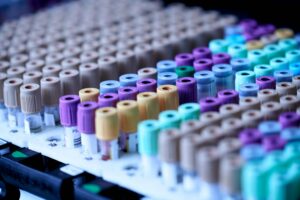
Sodium Citrate, is an anticoagulant which prevents clotting via the binding of calcium. The sodium citrate tube color is a blue top. The 2.7 ml tube is the most common size used and is the tube of choice for coagulation studies as well as platelet function testing. It is filled with a buffered solution containing 3.2% sodium citrate.
Even though sodium citrate and EDTA both stop clotting with similar mechanisms, sodium citrate is preferred due to its superior ability to preserve Factor V and Factor VIII3. The most common tests which use the blue top are the Prothrombin Time (PT), International Normalized Ratio (INR), activated partial thromboplastin time (aPTT), Thrombin Time, Fibrinogen, D-Dimer, Von Willebrand factor, various factor assays and platelet studies.
With other colored tubes, you can get away with underfilling the tube, if the patient is a hard stick. However, blue top tubes are unique in that they must be filled all the way to the top with blood. This is due to the ratio of 1 part citrate and 9 parts blood which is required to obtain the proper proportions. If an underfilled blue top tube is received in the lab, it will likely get rejected and a redraw of the specimen will be requested.
Variance Between Laboratories
Every laboratory is different, so some tests may not be run on certain tubes due to variance in instrumentation or policies. Because virtually all hematology tests use EDTA and coagulation studies use sodium citrate, this statement actually applies more to chemistry testing. For example, some methods for running a chemistry assay will require a serum sample, whereas others will require a plasma sample. This could mean the difference between using lithium heparin green tops versus a gold top serum separator tube (SST).
Conclusion
Lab testing relies heavily upon blood samples drawn in anticoagulated tubes. Without this, plasma and whole blood samples would not be possible, and serum would be the sole alternative. Furthermore, the mechanism of stopping the clotting process does matter, due to each anticoagulant having its own special characteristics. Using the wrong tube could cause erroneous results and negatively affect patient care.
References
1.Zahraini, H. I. (2021, November). Comparison of K2 and K3 EDTA Anticoagulant on Complete Blood Count and Erythrocyte Sedimentation Rate. Retrieved from Indonesian Journal Of Clinical Pathology: https://www.indonesianjournalofclinicalpathology.org/index.php/patologi/article/view/1735/pdf
2.Je Joon Ahn, M. &. (2002, June 1). A Correlation of Prothrombin Time in Citrated Specimens and EDTA Specimens Examined by Owren Method. Retrieved from Annals of Laboratory Medicine: https://www.annlabmed.org/journal/view.html?uid=1473&vmd=Full#:~:text=Background%20%3ASodium%20citrate%20has%20been,better%20in%20the%20EDTA%20specimen

